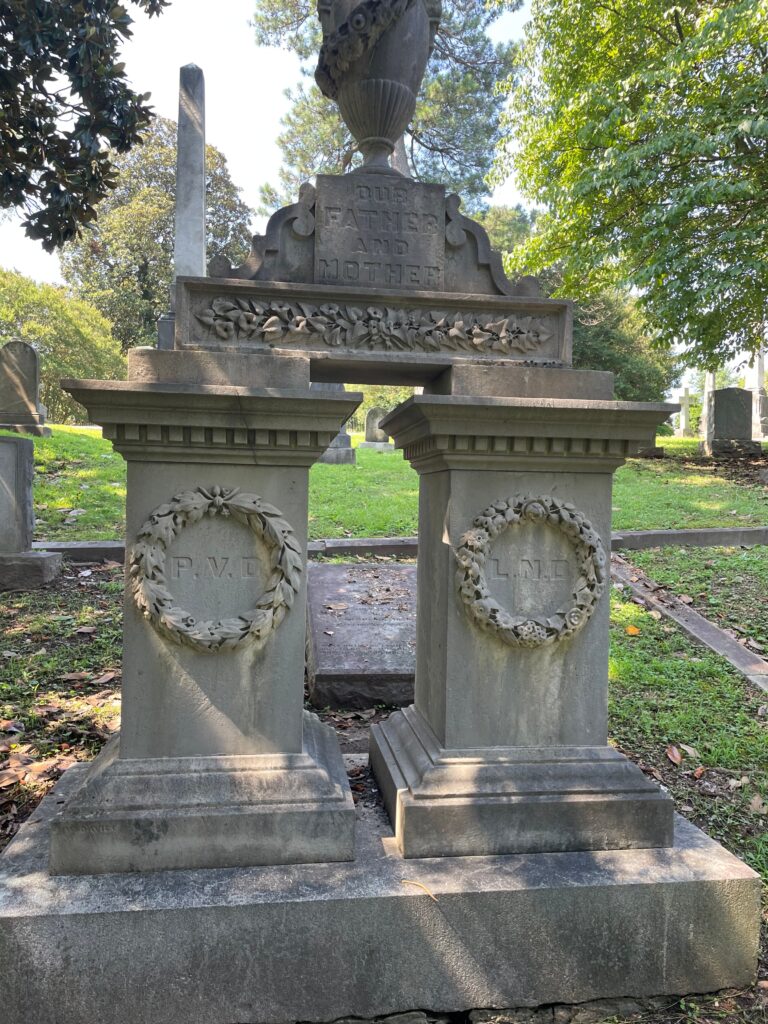Erik Visits an American Grave, Part 294
This is the grave of Peter Daniel.

One of the most reactionary Supreme Court justices in American history, Daniel was born in 1784 in Stafford County, Virginia to an elite slaveholding family. He attended the College of New Jersey, which today is Princeton, but didn’t care for it and after a year, returned to Virginia, moving to Richmond to go into the law. He studied under Edmund Randolph, who was the nation’s first attorney general, and went into practice. He later married Randolph’s daughter Lucy. He also engaged in the typical southern elite practice of dueling, killing a man in a duel that seems to have been over a political issue. A ritualized murder through a duel was no impediment to a successful political career in Virginia. He was elected to the House of Delegates in 1809 and as lieutenant governor in 1818. Daniel became a strong Jacksonian and was part of the Virginia Junta, a group of powerful state politicians that ran the state’s Democratic Party as it developed in the 1820s, first supporting their fellow southern elite William Crawford in the complicated 1824 election and then going all-in for Andrew Jackson in 1828. Daniel lost his bid for governor in 1830, but remained a major player in the Democratic Party.
Andrew Jackson rewarded Daniel for his loyalty in 1836 when he was appointed for a seat on the U.S. District Court for the Eastern District of Virginia. In an era that lacked the appeals court system we have today, this was a plum post for an ambitious politician. He was confirmed and then Martin Van Buren named him to the Supreme Court in 1841. In fact, that opening came up just eight days before Van Buren had to leave office and the Whig William Henry Harrison took over. But hey, Mitch McConnell’s actions are totally normal. The Whigs did try to fight this, but lost and Daniel ended up on the Court.
Daniel was the Court’s arch-conservative during his term. As southern nationalism around defending slavery grew, Daniel grew ever more attracted to it. He also eschewed the tradition of the time for the Court to issue unanimous decisions. He wrote 75 decisions in his years, 50 of them dissents. He wasn’t a very important jurist, never writing anything memorable or proving a leader of the other justices. He was just basically a plum reactionary. It wasn’t just that he saw the Whigs’ nationalism plans as wrong, he saw them as diabolically evil. He dissented in the 1849 Passenger Cases, which invalidated the ability to states to tax immigrants as a violation of the Commerce Clause. Daniel basically worried that would allow the British to offload free blacks into the South, his worst nightmare. Like reactionaries today, Daniel wanted the entire nation governed at the state and local level because it could be more easily be controlled by conservative interests. He even believed corporations should not be covered by federal courts, denying them the right to either sue or be sued in them. All this hardly made him some sort of proto-anti-capitalist. In 1848, he wrote the majority decision in West Ridge Bridge Company v. Dix, which gave states significant public domain rights to promote economic development. Daniel just wanted that power to exist exclusively at the state level so that no one could ever threaten southern slaveholder power.
In the 1842 Prigg case, he argued that not only was the early version of the Fugitive Slave Act constitutional and superseded a Pennsylvania law that prohibited the taking of African-Americans out of the state for the purposes of placing them in bondage, but that states not only can, but also should, take greater power to protect slaveholder interests, passing even more restrictive laws on fugitive slaves and that the state could use all means of force to enforce them. Not surprisingly, Daniel’s hatred of the federal government stopped at the moment where it could help him undermine states attacking his beloved slavery. He’d fit in quite well with the modern conservative movement.
How reactionary was Peter Daniel? In Dred Scott, he issued a concurring opinion that was significantly more extreme than Roger Taney’s notorious decision. Daniel believed the Northwest Ordinance, which banned slavery north of the Ohio River all the way back even before the Constitution was signed, was in fact unconstitutional and this was the basis for his disagreement with Taney. Daniel despised the north. He took a trip to New England in 1847 and hated every bit of it. Totally committed to the agrarian southern elite, he felt the hustle and bustle of mercantile capitalism was disgusting, even though of course the cotton that his fellow slaveholders grew was part and parcel of that system. For Daniel, slaves were not people, only property, and he believed that no ex-slave, no matter where they moved, had any right to citizenship. After his old mentor Martin Van Buren signed up for the Free Soil Party in 1848, more to get back at southern sectionalists destroying his beloved national party in the aftermath of them getting Polk nominated instead of him in 1844 than because he cared about fighting slavery, Daniel was disgusted and vowed to never travel north of the Mason-Dixon Line again. And in fact, he did not.
Daniel served on the Supreme Court for the rest of his life, which ended in 1860, when he died in Richmond at the age of 76.
Peter Daniel is buried in Hollywood Cemetery, Richmond, Virginia.
This grave visit was supported by LGM reader contributions and, as always, I am highly grateful. If you would like this series to visit more of our odious defenders of slavery, you can donate to cover the expenses here. Roger Taney alone would be worth it. Previous posts in this series are archived here.
